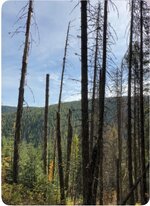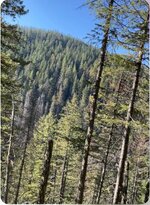Neckbone
Lil-Rokslider
- Joined
- Sep 21, 2022
- Messages
- 288
Planning my September elk rut hunt 2025 and scoring OnX and google maps. Backpack archery hunt.
I have been to this area before in 2019, my first year ever hunting out west. I have a lay of the land.. To paint the picture there is a large river bottom and road running North/South at 7500ft. Perpendicular to the main road are multiple rows of East/West drainages that are on average 2.5 miles long that you can walk up and gain roughly 750ft-1k in elevation. (Fairly steep but walkable ridges on either side 600ft up) When you reach the end of the drainages things get steep with passable routes to the higher up peaks. The higher stuff offers good glassing points down into the drainages. Would you...
A. Get up high into the higher stuff and glass for elk, then make your play from there when you find animals?
B. Start at the road before daylight and work your way up the drainage calling and glassing through the morning and into the day? Then hop to the next drainage/ridge top and work our way down from there..
We would like to spend nights up top the drainages or up in the high stuff, but I am afraid that the thermals will be working against us during early morning and evening prime time as our position would likely be from above.
How would you all work this area?
I have been to this area before in 2019, my first year ever hunting out west. I have a lay of the land.. To paint the picture there is a large river bottom and road running North/South at 7500ft. Perpendicular to the main road are multiple rows of East/West drainages that are on average 2.5 miles long that you can walk up and gain roughly 750ft-1k in elevation. (Fairly steep but walkable ridges on either side 600ft up) When you reach the end of the drainages things get steep with passable routes to the higher up peaks. The higher stuff offers good glassing points down into the drainages. Would you...
A. Get up high into the higher stuff and glass for elk, then make your play from there when you find animals?
B. Start at the road before daylight and work your way up the drainage calling and glassing through the morning and into the day? Then hop to the next drainage/ridge top and work our way down from there..
We would like to spend nights up top the drainages or up in the high stuff, but I am afraid that the thermals will be working against us during early morning and evening prime time as our position would likely be from above.
How would you all work this area?


